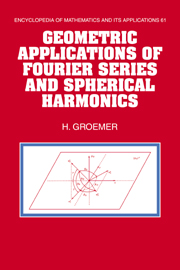3 - Fourier Series and Spherical Harmonics
Published online by Cambridge University Press: 11 September 2009
Summary
In this chapter we develop the theory of spherical harmonics to the extent necessary for our geometric applications. Occasionally, if it seems helpful for the understanding of the subject area, some topics will be developed in more detail or with a more general point of view than absolutely necessary for applications. As in the previous chapters it is always assumed that d ≥ 2. In some formulas presented in this chapter, particularly in Sections 3, 4, and 5, there arise products that are, strictly speaking, meaningless for certain values of the integers appearing in them; for example (d + 1)(d + 2) … (d + n − 1) if n = 1. Unless something else is explicitly stated, in all such situations the value of the product is defined to be 1.
From Fourier Series to Spherical Harmonics
We first list here a few basic facts from the theory of Fourier series. More precisely, we should say trigonometric or classical Fourier series since the term “Fourier series” has already been used in Section 1.1 in a more general setting. But it will always be clear from the context which kind of Fourier series is meant. It is not necessary to include here any proofs, since all the listed results are either well-known facts of basic real analysis or will be proved later in the more general context of spherical harmonics.
Information
- Type
- Chapter
- Information
- Publisher: Cambridge University PressPrint publication year: 1996
